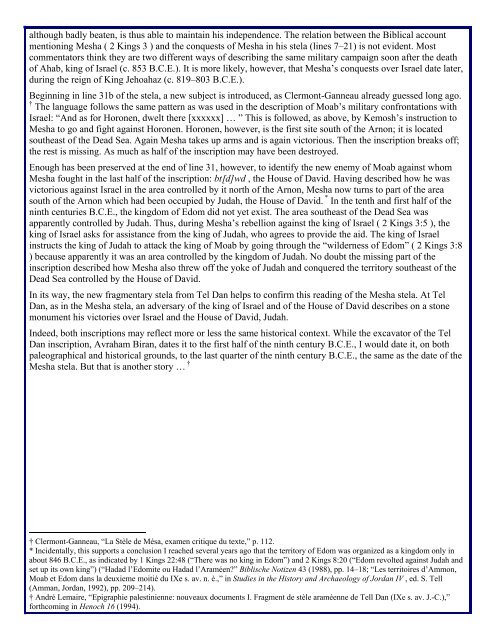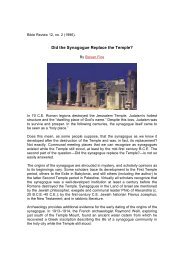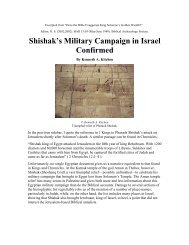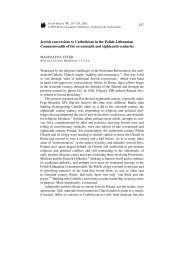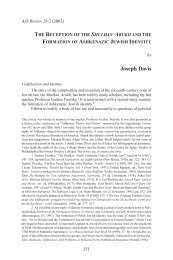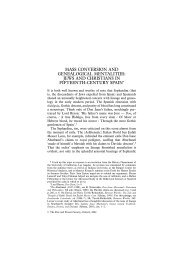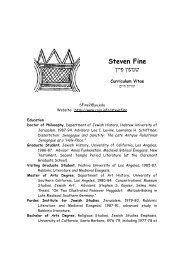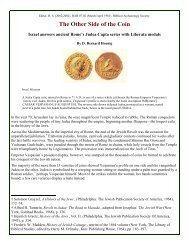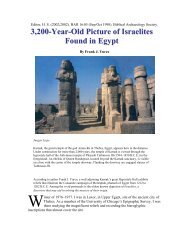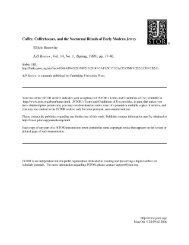“House of David” Restored in Moabite Inscription
“House of David” Restored in Moabite Inscription
“House of David” Restored in Moabite Inscription
Create successful ePaper yourself
Turn your PDF publications into a flip-book with our unique Google optimized e-Paper software.
although badly beaten, is thus able to ma<strong>in</strong>ta<strong>in</strong> his <strong>in</strong>dependence. The relation between the Biblical account<br />
mention<strong>in</strong>g Mesha ( 2 K<strong>in</strong>gs 3 ) and the conquests <strong>of</strong> Mesha <strong>in</strong> his stela (l<strong>in</strong>es 7–21) is not evident. Most<br />
commentators th<strong>in</strong>k they are two different ways <strong>of</strong> describ<strong>in</strong>g the same military campaign soon after the death<br />
<strong>of</strong> Ahab, k<strong>in</strong>g <strong>of</strong> Israel (c. 853 B.C.E.). It is more likely, however, that Mesha’s conquests over Israel date later,<br />
dur<strong>in</strong>g the reign <strong>of</strong> K<strong>in</strong>g Jehoahaz (c. 819–803 B.C.E.).<br />
Beg<strong>in</strong>n<strong>in</strong>g <strong>in</strong> l<strong>in</strong>e 31b <strong>of</strong> the stela, a new subject is <strong>in</strong>troduced, as Clermont-Ganneau already guessed long ago.<br />
† The language follows the same pattern as was used <strong>in</strong> the description <strong>of</strong> Moab’s military confrontations with<br />
Israel: “And as for Horonen, dwelt there [xxxxxx] … ” This is followed, as above, by Kemosh’s <strong>in</strong>struction to<br />
Mesha to go and fight aga<strong>in</strong>st Horonen. Horonen, however, is the first site south <strong>of</strong> the Arnon; it is located<br />
southeast <strong>of</strong> the Dead Sea. Aga<strong>in</strong> Mesha takes up arms and is aga<strong>in</strong> victorious. Then the <strong>in</strong>scription breaks <strong>of</strong>f;<br />
the rest is miss<strong>in</strong>g. As much as half <strong>of</strong> the <strong>in</strong>scription may have been destroyed.<br />
Enough has been preserved at the end <strong>of</strong> l<strong>in</strong>e 31, however, to identify the new enemy <strong>of</strong> Moab aga<strong>in</strong>st whom<br />
Mesha fought <strong>in</strong> the last half <strong>of</strong> the <strong>in</strong>scription: bt[d]wd , the House <strong>of</strong> David. Hav<strong>in</strong>g described how he was<br />
victorious aga<strong>in</strong>st Israel <strong>in</strong> the area controlled by it north <strong>of</strong> the Arnon, Mesha now turns to part <strong>of</strong> the area<br />
south <strong>of</strong> the Arnon which had been occupied by Judah, the House <strong>of</strong> David. * In the tenth and first half <strong>of</strong> the<br />
n<strong>in</strong>th centuries B.C.E., the k<strong>in</strong>gdom <strong>of</strong> Edom did not yet exist. The area southeast <strong>of</strong> the Dead Sea was<br />
apparently controlled by Judah. Thus, dur<strong>in</strong>g Mesha’s rebellion aga<strong>in</strong>st the k<strong>in</strong>g <strong>of</strong> Israel ( 2 K<strong>in</strong>gs 3:5 ), the<br />
k<strong>in</strong>g <strong>of</strong> Israel asks for assistance from the k<strong>in</strong>g <strong>of</strong> Judah, who agrees to provide the aid. The k<strong>in</strong>g <strong>of</strong> Israel<br />
<strong>in</strong>structs the k<strong>in</strong>g <strong>of</strong> Judah to attack the k<strong>in</strong>g <strong>of</strong> Moab by go<strong>in</strong>g through the “wilderness <strong>of</strong> Edom” ( 2 K<strong>in</strong>gs 3:8<br />
) because apparently it was an area controlled by the k<strong>in</strong>gdom <strong>of</strong> Judah. No doubt the miss<strong>in</strong>g part <strong>of</strong> the<br />
<strong>in</strong>scription described how Mesha also threw <strong>of</strong>f the yoke <strong>of</strong> Judah and conquered the territory southeast <strong>of</strong> the<br />
Dead Sea controlled by the House <strong>of</strong> David.<br />
In its way, the new fragmentary stela from Tel Dan helps to confirm this read<strong>in</strong>g <strong>of</strong> the Mesha stela. At Tel<br />
Dan, as <strong>in</strong> the Mesha stela, an adversary <strong>of</strong> the k<strong>in</strong>g <strong>of</strong> Israel and <strong>of</strong> the House <strong>of</strong> David describes on a stone<br />
monument his victories over Israel and the House <strong>of</strong> David, Judah.<br />
Indeed, both <strong>in</strong>scriptions may reflect more or less the same historical context. While the excavator <strong>of</strong> the Tel<br />
Dan <strong>in</strong>scription, Avraham Biran, dates it to the first half <strong>of</strong> the n<strong>in</strong>th century B.C.E., I would date it, on both<br />
paleographical and historical grounds, to the last quarter <strong>of</strong> the n<strong>in</strong>th century B.C.E., the same as the date <strong>of</strong> the<br />
Mesha stela. But that is another story … †<br />
† Clermont-Ganneau, “La Stèle de Mésa, examen critique du texte,” p. 112.<br />
* Incidentally, this supports a conclusion I reached several years ago that the territory <strong>of</strong> Edom was organized as a k<strong>in</strong>gdom only <strong>in</strong><br />
about 846 B.C.E., as <strong>in</strong>dicated by 1 K<strong>in</strong>gs 22:48 (“There was no k<strong>in</strong>g <strong>in</strong> Edom”) and 2 K<strong>in</strong>gs 8:20 (“Edom revolted aga<strong>in</strong>st Judah and<br />
set up its own k<strong>in</strong>g”) (“Hadad l’Edomite ou Hadad l’Araméen?” Biblische Notizen 43 (1988), pp. 14–18; “Les territoires d’Ammon,<br />
Moab et Edom dans la deuxieme moitié du IXe s. av. n. è.,” <strong>in</strong> Studies <strong>in</strong> the History and Archaeology <strong>of</strong> Jordan IV , ed. S. Tell<br />
(Amman, Jordan, 1992), pp. 209–214).<br />
† André Lemaire, “Epigraphie palest<strong>in</strong>ienne: nouveaux documents I. Fragment de stèle araméenne de Tell Dan (IXe s. av. J.-C.),”<br />
forthcom<strong>in</strong>g <strong>in</strong> Henoch 16 (1994).


